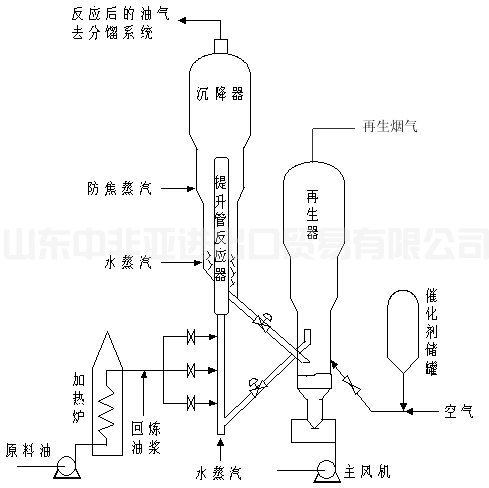
Schematic diagram of process flow of reaction-regeneration system
Catalytic cracking process:
Catalytic cracking is the most important process in the secondary processing of crude oil, and it is the main production means of liquefied petroleum gas, gasoline, kerosene and diesel oil, and plays an important role in the refinery.
Catalytic cracking generally uses vacuum distillate oil and coke wax oil as raw materials, but with the increasing trend of crude oil and the market's large demand for light oil products, some refineries began to blend vacuum residue, and even directly use atmospheric residual oil as cracking raw materials.
Process flow of catalytic cracking
The catalytic cracking unit generally consists of three parts: reaction-regeneration system, fractionation system and absorption-stabilization system. Among them, the reaction-regeneration system is the core part of the catalytic cracking unit, and its device types are mainly bed reaction type, lifting tube type, lifting tube type is divided into high and low parallel type and coaxial type. Although the reaction-regeneration system of different device types will be slightly different, but its principle is the same, the following is a simple introduction to the high-low parallel riser catalytic cracking as an example, the process flow of the reaction-regeneration system is shown in the figure above.
① Reaction-regeneration system
After heat transfer, the fresh raw oil is mixed with the oil refining, heated to 300 ~ 400℃ by the heating furnace, and enters the nozzle at the lower part of the riser reactor, and atomizes with steam into the lower part of the riser, contacts with the high temperature catalyst (600 ~ 750℃) from the regenerator, and then gasification and reaction are carried out. The residence time of oil and gas in the lifting pipe is very short, generally 2 to 4 seconds. After the reaction, the oil and gas enter the gas collecting chamber through the cyclone separator and enter the fractionation system through the top outlet of the settler.
The regenerated catalyst (pending catalyst) with coke accumulated enters the stripping section below by the settler, and is striped with superheated water steam to remove a small amount of oil and gas adsorbed on the surface of the pending catalyst, and then enters the regenerator through the inclined pipe and the single acting slide valve to contact the air from the bottom of the regenerator to react, restore the activity of the catalyst, and release a lot of heat.
② Fractionation system
The function of this part is to preliminarily separate the products of the reaction-regeneration system to obtain partial products and semi-finished products.
③ Absorption - stabilization system
This part includes an absorption tower, a desorption tower, a reabsorption tower, a stabilization tower and the corresponding cooling and heat exchange equipment. The purpose is to separate the components below C2 from the components above C3 in the rich gas from the fractionation part for separate use, and at the same time to separate a small amount of gas hydrocarbons mixed in gasoline to reduce the vapor pressure of gasoline.
 简体中文
简体中文
